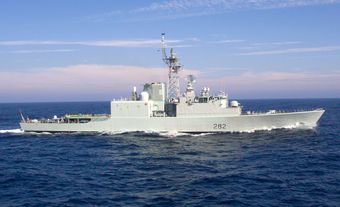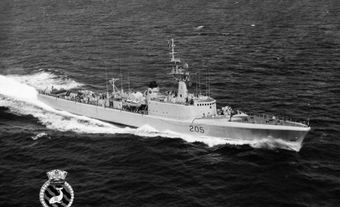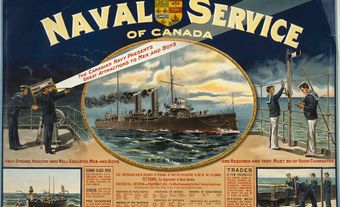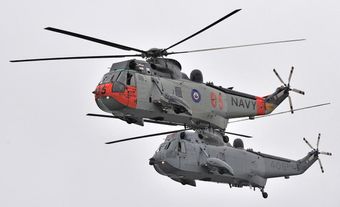The Halifax class of helicopter-carrying frigates (FFH) are multi-purpose warships of the Royal Canadian Navy (RCN). There are 12 ships in the class. They were conceived in the 1970s as a replacement of the St Laurent and related classes of destroyer escorts, to provide antisubmarine warfare (ASW) protection for the fleet. The Halifax class entered service in the early 1990s, just after the end of the Cold War, and proved instead to be highly versatile general-purpose warships. Due to a major class-wide modernization project completed in the 2010s, they remain the backbone of the RCN surface fleet. The Halifax class will be replaced in the 2030s by the Canadian Surface Combatant (CSC) ships announced in 2019.

Canadian Patrol Frigate (CPF)
In the early 1970s, four Iroquois-class destroyers were acquired by the Canadian navy as follow-ons to the St Laurents. However, they proved to be much larger and more expensive than intended. The navy quickly renewed its search for a more economical replacement surface ASW warship.
At about the same time, the United States Navy (USN) developed the towed array sonar, which adapted passive sonar arrays from the SOSUS network. This was a major technological breakthrough, as detection ranges were much higher than active sonar. Towed array sonar fundamentally changed the concept of surface ASW, from close-in convoy protection to ships stationed singly at some distance from the main force. As such ships operated independently, they needed enhanced self-defence capabilities.
In December 1977, Cabinet endorsed these concepts, which would be incorporated in the new Canadian Patrol Frigate (CPF). To avoid the cost overruns experienced with the in-house Iroquois project, Cabinet decided that the CPF project would be handled by an external contractor. The government invited companies to tender bids, which had to meet specific operational and technical requirements. This was a first for a major Canadian defence project, and a process that has continued since.
Design
The winning design by Saint John Shipbuilding Limited was revolutionary: in addition to a Canadianized towed array sonar system (CANTASS) as the primary sensor, the ship embarks a large ASW helicopter as the primary weapon-delivery platform (first the CH-124 Sea King, replaced in 2018 by the CH-148 Cyclone). The ship also has a 57mm Bofors rapid-firing gun for surface and air defence, as well as Sea Sparrow missiles and a Phalanx CIWS (close-in weapons system) for point air defence, and Harpoon surface-to-surface missiles (SSM) for defence against surface threats. It also carries 24 antisubmarine torpedoes and eight 12.7mm heavy machine guns. All are managed through a sophisticated computerized command and control system (CCS-330). The ship is powered by combined diesel and gas turbine propulsion (CODOG). It has a maximum range of 7,100 nautical miles (13,149 km) at 15 knots on the diesels and 4,700 nautical miles (8,704 km) at 15 knots using the gas turbines, with a top speed of about 30 knots (56 km/h) with the latter. At a displacement of 4,770 tons, it is only slightly smaller than the 5,200-ton Iroquois class. Practically every function is controlled through a series of “ship integrated” computerized systems: communications (SHINCOM), machinery control (SHINMACS), and processing and display (SHINPADS).
Halifax Class
The winning design was accepted in July 1983 with an initial order for “Batch 1” of six ships. This was soon followed with an order for Batch 2 of six more ships in December 1987. There was a contingency plan for an additional Batch 3 of six to eight ships, to complete the one-for-one replacement of the 20 St Laurents; however, it was set aside as a “peace dividend” defence reduction with the end of the Cold War.
The ships were named after major Canadian cities, with the lead ship Halifax (330) laid down in March 1987 and “floated-up” (that is, built in and launched from a drydock) on 30 April 1988; after a lengthy period of fitting out and acceptance trials, the ship was formally commissioned on 29 June 1992. The remainder in the class are Vancouver (331), Ville de Québec (332), Toronto (333), Regina (334), Calgary (335), Montréal (336), Fredericton (337), Winnipeg (338), Charlottetown (339), St. John’s (340) and Ottawa (341). The last to be commissioned was Ottawa, on 28 September 1996.

Life Extension and Modernization (HCM / FELEX)
Upon introduction, the Halifax class was immediately recognized as a world leader in ASW. At about the same time, however, the Cold War ended. The effective disappearance of the Soviet submarine fleet as an adversary meant the Halifax class had few chances to demonstrate its open ocean ASW capabilities on operations. Instead, the ships were deployed to littoral environments (see “Employment” below) with shore-based threats requiring upgrades and changes to their sensors and weapons.
The Frigate Equipment Life Extension Project (FELEX) was initiated in November 2001, with the mid-life Halifax Class Modernization Project (HCM) approved in 2005. The lead ship Halifax was first to enter the yard in the spring of 2010, and the last ship (Toronto) completed acceptance trials in December 2017. In addition to a comprehensive upgrade of the Combat Control System (CCS) and fitting of enhanced sensors and weapons such as the Evolved Sea Sparrow Missile (ESSM), the projects also incorporated changes required for introduction of the CH-148 Cyclone helicopter.
With incremental upgrades through the course of regularly planned cyclical refits, the Halifax class is expected to remain operational through the 2030s. In February 2019, a contract was signed with a consortium of BAE-Lockheed Martin for up to 15 of the British Type 26 frigates as the replacement Canadian Surface Combatant (CSC). These will be built by Irving Shipbuilding Inc., as one-for-one replacements of the 12 Halifax and three Iroquois destroyers.
Employment
Built for operations in the North Atlantic and Pacific Oceans, seven of the ships are based in Halifax and five in Esquimalt. They have also been deployed to the far reaches of the globe, generally with allied or coalition forces, sometimes as a Canadian Task Group (most notably in the Arabian Sea region in support of the war in Afghanistan), but more often as single ships. Soon after commissioning, Calgary deployed to the Persian Gulf region as the first allied warship ever fully integrated with a USN carrier battle group. The farthest domestic operation saw Fredericton deployed covertly off the coast of Angola in the spring of 2006, in support of an RCMP drug operation. On a rotational basis, the frigates Charlottetown and Vancouver saw inshore action in the operations against Libya in 2011. More recently, a frigate regularly participates in sanction enforcement against North Korea (Operation Neon) and in European waters against a resurgent Russia (Operation Reassurance). Indeed, a return of Russian nuclear-powered ballistic missile-firing submarines to Cold War-levels in the late-2010s has led to renewal of the original ASW purpose of the Halifax-class frigates.

 Share on Facebook
Share on Facebook Share on X
Share on X Share by Email
Share by Email Share on Google Classroom
Share on Google Classroom




